Why your salmon sandwich is disastrous for the environment – but saving the economy
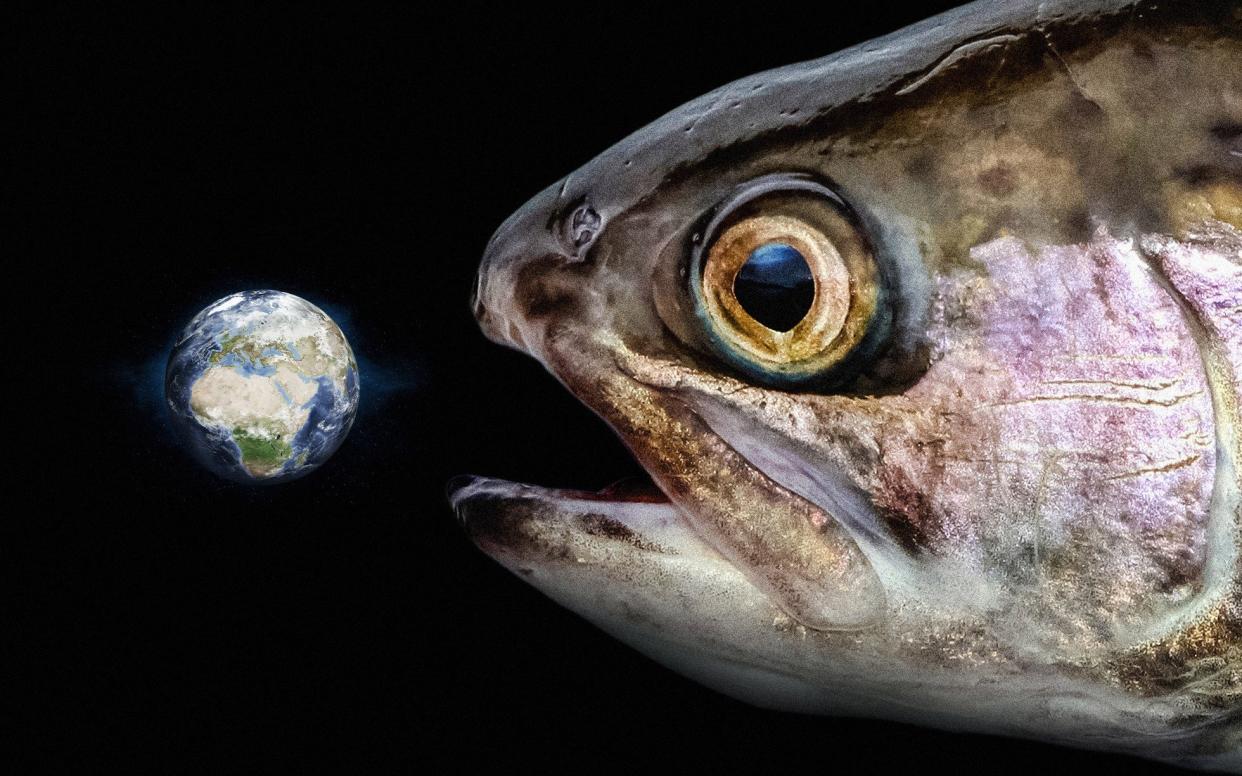
From the A382, which runs high above Little Loch Broom, you can see the salmon thrashing about in their cages. Every second or two a fish breaks the surface and catches the sunshine, a furious flash of silver above the deep blue water. A few lonely employees stand on the farms, which comprise eight square enclosures in two rows of four, a hundred yards or so from the shore. In the background, the peninsula rises to a steep rocky peak. As locations for a farm go, they do not come much more picturesque than Wester Ross, 50 miles or so northwest of Inverness. George RR Martin was so impressed he took the name “Westeros” for his fictional continent in the Game of Thrones books.
If the scenery is evocative, few sights are more emblematic of Scotland than a leaping salmon. But these are not running upstream or squirming on a line. Instead they are being raised, in their millions, to satisfy Britain’s endless hunger for pink-orange flesh. Every time you eat a smoked salmon sandwich, or pick up a couple of fillets for supper, you are participating in perhaps the most bitter conflict in British food production, a row which worsens by the month.
“It’s a really contentious issue in Scotland,” says Rachel Mulrenan, a director at WildFish, a charity which works to protect wild fish. “It’s very vitriolic, between the industry and campaigners who are against it and people who are employed by it.
“But it has been difficult sometimes to make the connection in people’s minds between what’s happening in a sea loch in Scotland, what’s happening to the environment, and what you’re eating when you go to Pret and buy a salmon sandwich.”
Salmon farming’s critics, who include environmentalists, merchants and chefs, say it is a vile aquatic version of factory farming: disastrous for the fish, the environment and consumers. They point to rising cases of lice, disease and other conditions, and levels of mortality in the fish, not to mention fatty, flavourless meat. On the other side, salmon farming’s supporters argue that it is one of the great recent innovations in protein production, a new supply of good-value, healthy food that provides jobs and revenues to a part of the world that badly needs them, and which is subject to increasingly stringent regulation.
In March, the most prominent anti-salmon-farming activist, Don Staniford, lost an appeal against a court order banning him from any property owned by Mowi, the Norwegian-owned fish farming company that is Scotland’s biggest. In recent years Staniford has regularly made headlines for his campaigns, which use footage obtained from underwater cameras to show the poor conditions in which salmon are kept. When I contact Staniford, he asks if I can kayak and invites me to come out on an expedition later in the summer.
“Salmon farming impinges on nature,” he says. “By filming inside cages we’ve exposed welfare abuse. In simplistic terms, salmon farming is environmentally bankrupt, ethically bankrupt and the third impact is from a food safety public health point of view.” He adds that salmon suffer from not being thought of as sympathetically as some other animals.
“You have the fluffy pandas, kittens and seals but a sloppy stinky fish is not the same in people’s image of what constitutes welfare abuse,” he says. “But fish are sentient. Fish feel pain.”
At Mowi they feel the fight is unfair. “The industry is dogged by vicious activism,” says Ben Hadfield, Mowi’s chief operating officer. “It’s an easy subject to attack because it’s quite technical, it’s quite a new farming industry – we’ve only been around about 60 years – and because it takes place underwater there’s a lot of misinformation out there. We also have one or two individuals who have made it their career to attack fish farming.
“The tactics are guerilla warfare. As part of a well-run Scandinavian-based company, everything I say has to be evidence-based and accurate. The activists’ takes are, at best, grossly unfair.” The company argues its practices are held to extremely high standards.
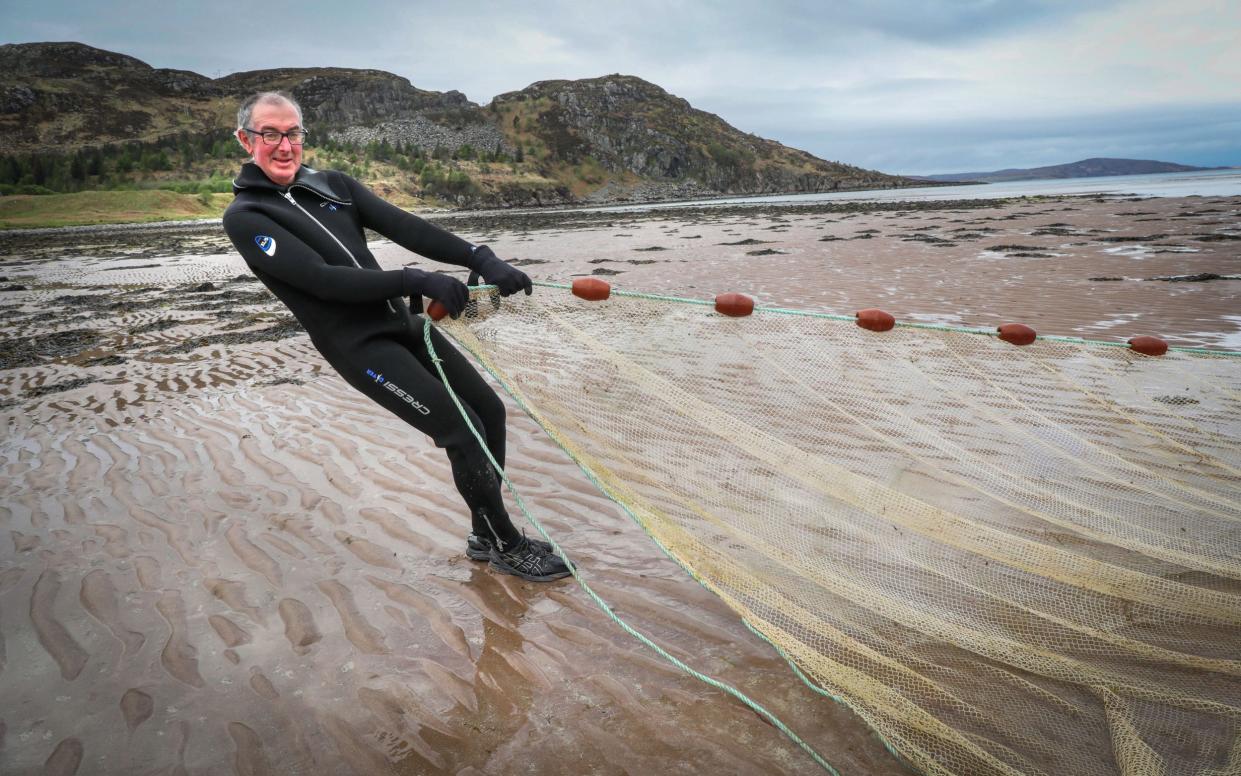
On Gruinard beach, a few miles south of Loch Broom, Peter Cunningham lets me tag along while he fishes for wild trout. As a biologist at Wester Ross Fisheries, he is responsible for monitoring the well-being of wild fish across the area. With the help of a few cheerful volunteers, he slings a large net across the mouth of a little river, near where it meets the sea. People have always fished for trout around here, for food or for sport – a salmon is engraved on the 1,500-year-old Pictish stone in Gairloch Museum down the road – but Cunningham is here for a less happy reason: looking for sea lice. All sides of the salmon argument agree that sea lice are a problem, even if they disagree on the cause.
These tiny parasitic crustaceans, lepeophtheirus salmonis, attach themselves to the outside of fish and feast on them. In enough numbers, they can kill the fish. A salmon farm can contain up to a million fish in a single pen; as fleas might enjoy a crowded commuter carriage, these lice proliferate when the fish are packed in fin by gill, resembling a living tin. Activist footage taken from inside pens of fish show salmon being eaten alive by lice. Because the cages are open to the sea, the lice can drift and attach to wild fish. By checking the wild trout, Cunningham can help assess the scale of the problem.
“The lice come from both farms and wild fish to infect the fish on the farms, and then they multiply,” he says. “It’s the multiplication factor, one or two, maybe three orders of magnitude above natural parasite levels, that does the wild fish in. The farms are so big that a single fish farm will have more salmon in it than all the wild salmon in Scotland. So you’re dealing with more hosts for the parasite. They can have two or three generations during a two-year farm production cycle, which means the population of parasites can drift between farms, infect each other and wild fish. The parasite population goes way higher than it would have been historically.”
“The challenge [of sea lice] comes down to money,” he adds. “The farms say it’s their biggest problem. Even one or two lice per farmed fish can cause problems because of the sheer number of hosts. If your farm has a million salmon and each has a louse, then that’s a million adult female lice shedding eggs into the water.
“I’m not going to say that lice are the only problem for wild salmon. There are lots of other problems. But there is a very clear picture in Wester Ross between rivers that are furthest from fish farms compared to those close to fish farms where smolts [young salmon or trout] have to swim past 10 farms on their way out to sea. We are keen to prevent further expansion of salmon farming within the Wester Ross Marine Protected Area to protect the wild salmon populations.”
Cunningham would like wild salmon protected areas “to protect the habitat, at least until the farms have consistently demonstrated that they can keep the lice levels down”.
“They’re not doing it. They can’t argue that they’re managing [effectively] for wild fish,” he says.
Lice is only one of the problems facing a farmed salmon, which has a tough life. It spends its first year in fresh water, growing through stages – alevin, fry, parr and smolt, by which point it weighs anything up to 150g. Then it is transferred to its salt water pen, where it lives for up to another two years before it is ready to be harvested. Along the way the fish is at risk of amoebic gill disease, fungal infection, infectious salmon anaemia, bacterial kidney disease, cardiomyopathy syndrome, skeletal muscle inflammation and winter sores. Recently salmon populations have also fallen victim to swarms of tiny jellyfish, and possibly water depleted of oxygen by algal blooms. In the months towards the end of last year, the Scottish salmon industry was reporting monthly mortality rates of 5 per cent.
Salmon farmers treat the pens for lice, washing the fish off in cold water or treating them with drugs or chemicals. They say that global sea temperature rises are responsible for the increase in problems, rather than the conditions on their farms. “The jellyfish used to be brought up on the tide from the English channel,” says Gareth Moore, editor of FishFarming expert, a trade publication. “But the warming water appears to have brought them to the point where they may be resident in Scottish waters.”
That’s before the knock-on effects further down the supply chain. A farmed salmon typically requires more than a kilo of food, which mostly comprises other fish, to gain a kilo of body weight. In 2020, more than 16 million tons of wild fish, a fifth of all the wild fish caught, ended up as meal or oil to feed other fish. In West African countries, including Senegal and Mauritania, overfishing for small fish has caused stocks to plummet and prices to rise, making fish less affordable for locals to eat.
While the east coast of Scotland has oil, the west coast has historically relied on tourism and fishing. Tourism continues, not least thanks to the NC500 road route, which causes the roads to routinely clog up with camper vans and motorbikes. Fishing for food has all but died out. Sport fishing is all catch and release. Families who once lived by the sea have fewer options than they used to.
Ian McWhinney lives on Dry Island, a few miles around the coast from Gairloch, a few miles to the south of Loch Broom. His family has lived here for hundreds of years: his home, accessed via a pontoon bridge, was once a fish-smoker, where they made red herrings. As fishing became less viable, Ian moved into giving shellfish tours, looking for crabs, lobsters and other crustaceans.
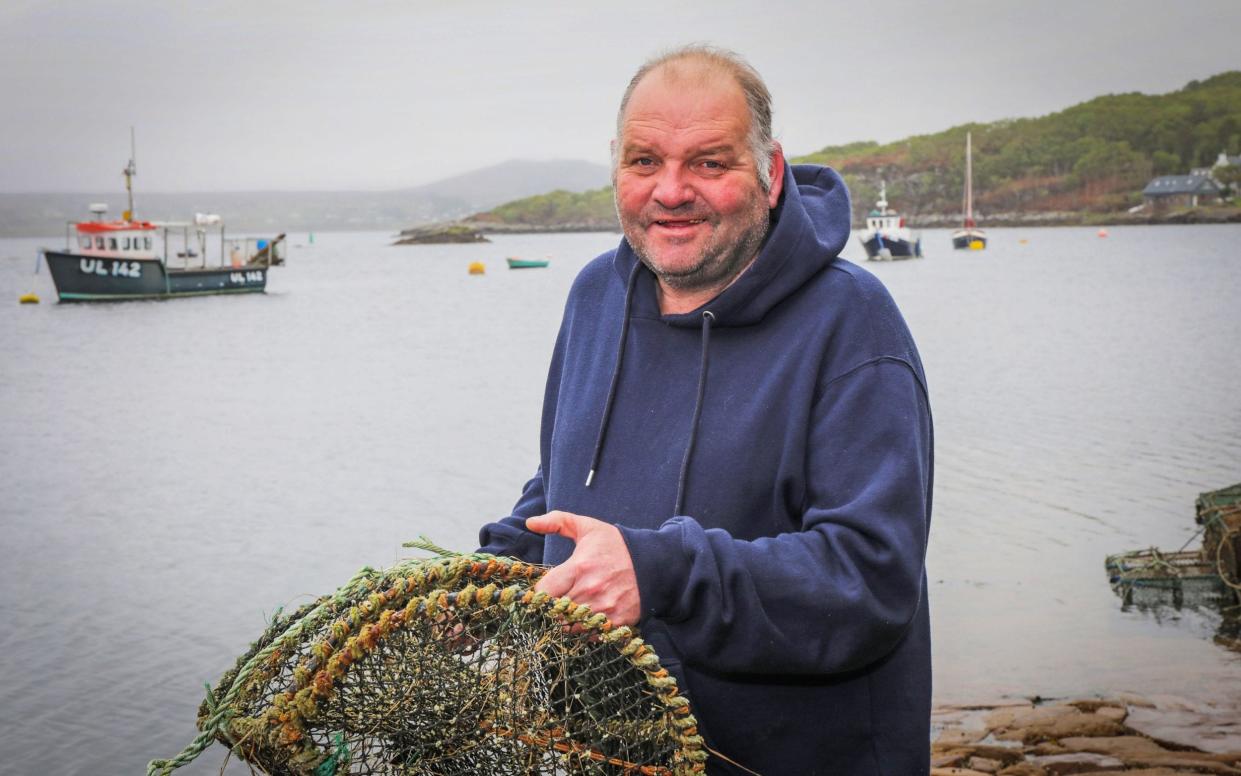
“I’ve seen the ups and downs of salmon from my window,” he says. “When I was young we would see lots of salmon and sea trout jumping in the water. The last time I saw a salmon jumping was probably about seven years ago. I firmly believe that fish farming has been [responsible for] the decline in the salmon population here, through disease, sea lice especially.”
In the time he has been sailing these waters and watching them from his window, McWhinney has seen fish farming grow from a cottage industry into a multi-million pound, heavily technological behemoth. “I’ve seen it develop from a very small thing,” he says. “A few crofters would get together, have a little wooden pen out in the sea and grow a thousand fish. That’s still the farmers’ line when they push these things – the advert has a little wooden boat and two guys with a drift net. It’s the same as if you’re selling chicken nuggets you’re not going to show pictures of battery farms are you.”
McWhinney even worked on a farm himself for a while. “When I was 25 it was great,” he says. “But as it became more and more industrialised they employed only four or five people. You no longer harvest the fish on site. A boat comes and sucks up all the fish and takes them away. I thought farming would have been a great idea if it had been kept smaller-scale, but it wasn’t. It was taken over, which introduced all these problems.”
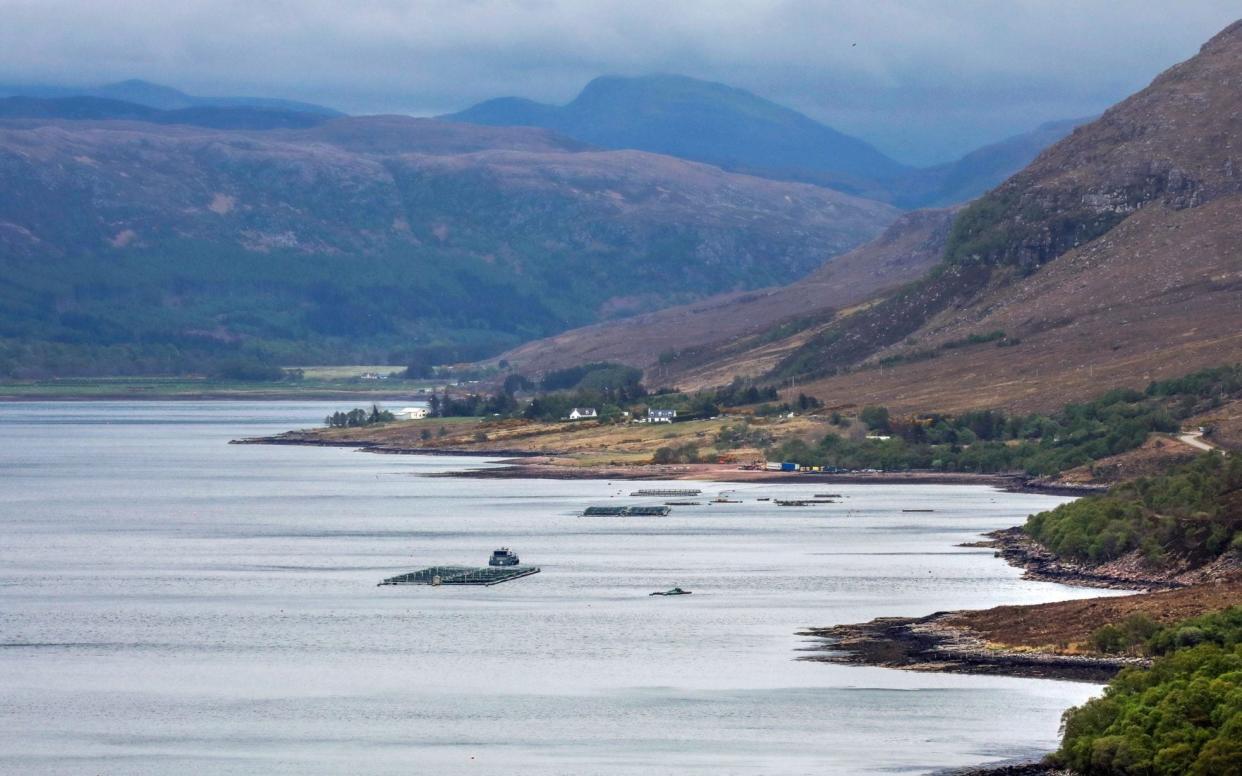
The problems have arisen against a backdrop of business success. According to Salmon Business, an industry body, salmon is the most popular fish in the UK, with sales up 3.2 per cent year on year. Scottish salmon is the UK’s number one food export, accounting for £580.6 million of trade last year. Farms directly employ more than 2,000 people, with another 10,000 jobs dependent on farm-raised salmon. Many farms are in remote areas, with limited other employment options.
“The farms don’t directly employ that many people, but if you look at the areas where they’re employed, those jobs are very important because there’s no alternative for a lot of them,” says Gareth Moore. “You’ve all the usual arguments about them preventing depopulation and keeping schools open. They are very important to the economy in certain places.” I hear from one young man, who doesn’t want to be named, who has worked for Mowi for five years. He says he’s very happy with the job. He is employed two weeks on, two weeks off and is well paid, with food and accommodation allowances when working.
As the salmon business has grown, it has become politically important, too. Scotland remains a minnow in farming terms compared to Norway, which produces seven times as much per year (1.4 million tons to Scotland’s 200,000), or Chile, but it is growing. For an SNP keen to show that the country could be economically independent, salmon looks like pink gold.
“For obvious reasons we now have a transition away from oil and gas,” says Mulrenan, from WildFish. “Salmon aquaculture in its early years was seen as an alternative rival industry, as an economic powerhouse. Increasingly, it’s become clear it’s not going to be sustainable in its current form. But we have a government whose primary goal is independence.” As long as the SNP is in power, Holyrood seems likely to continue to support salmon farming.
Wester Ross has particular resonance in the salmon world. Until a couple of years ago, it was the last independently owned farming operation, the only one holding out against the multinationals, four of whom - Mowi, Salma (both Norwegian), Bakkafrost (Faroese) and Cooke Aquaculture (Canadian) dominate Scottish salmon farming. Wester Ross was a byword for sustainably farmed salmon, with a ratio of one fish to 99 parts water. Yet even they eventually succumbed, selling to Mowi in 2022. Its former boss, Gilpin Bradley, who stepped down last year after 33 years in charge, remains proud of his achievement. “Irrespective of what the critics say, salmon farming has been a phenomenal success,” he says. “And the reason it has been successful is because of the incredible level of investment that’s gone into improving how it’s farmed. There’s always teething problems in any growing industry, and farming the sea does attract an awful lot of critics. But it’s an industry that’s here to stay.
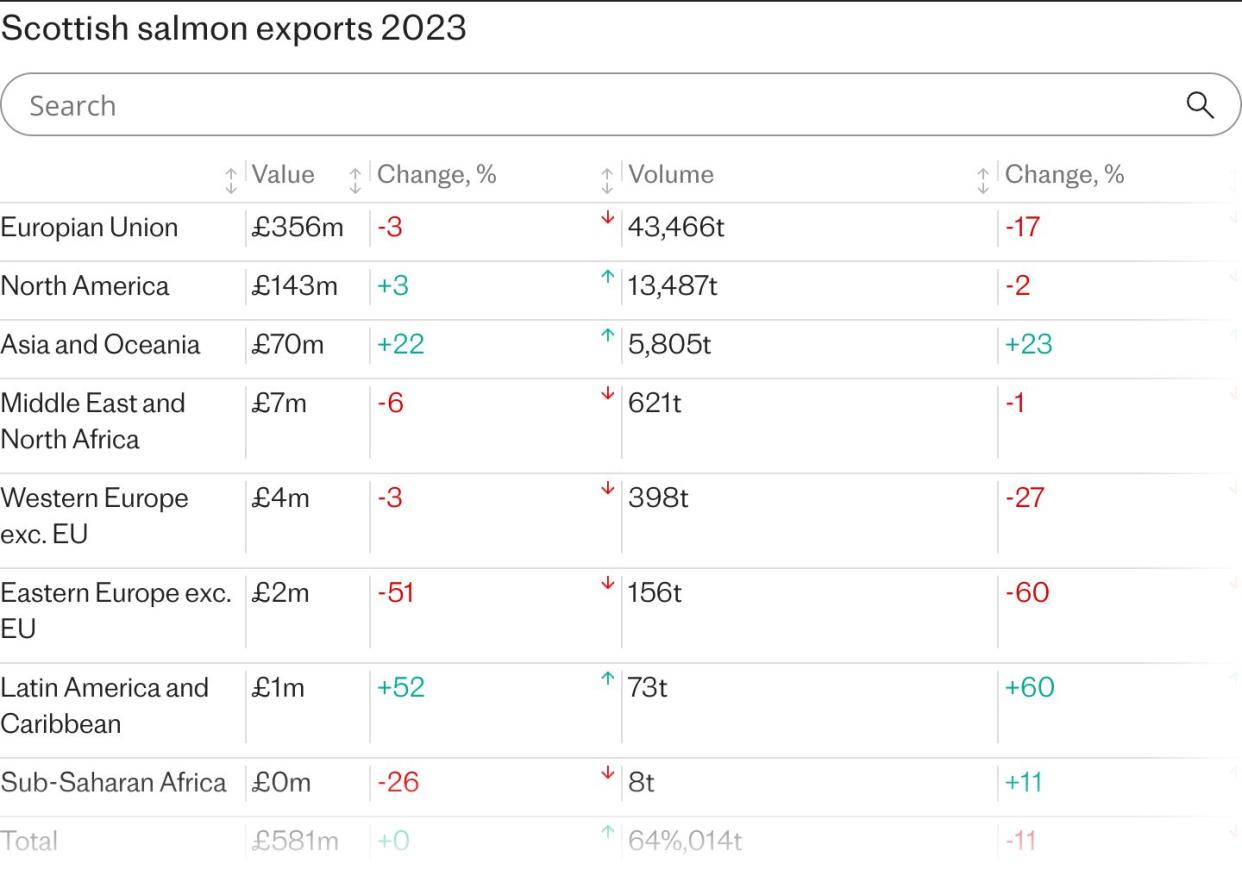
“The reason we were able to hold on for so long as an independent is we took a very transparent approach to farming our salmon,” he adds. “Feeding the world is only going to happen out of growing more protein at sea. It won’t happen on land. One must embrace the blue revolution. Yes, it needs to be controlled and heavily regulated, but there’s more regulation associated with farming salmon than with any [other] protein production in the UK.
“Ring a chicken farmer and ask him what his survival rate was from his last batch – it’s probably less than 80 per cent, and that’s over 50 days. In salmon there is a lot of criticism for the level of mortality, but it’s over a long production cycle.”
Bradley has little time for Don Sandiford and his fellow activists. “Salmon farmers face professional paid critics whose sole job is to destroy the salmon farmer,” he says. “They will resort to endless provocative tactics and tricks and photographs to get their story across. I can’t say I’ve ever come across a criticism that’s been fair.”
None of which has stopped many top chefs from abandoning farmed fish altogether amid concerns over its provenance, while many restaurants, including the Michelin-starred St John, in London, and Grace & Savour, in the West Midlands, have stopped selling it altogether. Rick Stein gets his smoked salmon from the Severn & Wye smokery, which sources its fish from the Faroe Islands. There is no wild salmon fished commercially anywhere in the UK; even artisanal smokers source fish from Scottish farms.
A few years ago I bought a memorably tasty Wester Ross whole salmon from Pesky Fish, a start-up that aims to cut out the middle-men in the fish business, matching consumers more directly to suppliers. They have stopped working with Wester Ross since the sale.
“We have stopped selling raw salmon on the basis that quality across the board has gone down since we started in 2018,” says Ben King, the chief executive of Pesky Fish. They have moved to chalk stream trout as a source of more sustainable, tastier pink fish.
“We’ve often found that producers who rely on animal husbandry as their primary ‘claim’ do so to distract from harmful and unsustainable practices across other parts of their operation,” he adds. “‘We cuddle our salmon, but don’t look at all the crap underneath the pens that’s harming the surrounding marine environment.
“Moreover, in order to remain in business, the organisations behind these certifications are accepting lower and lower standards as time goes by – completely undermining their existence in the first place. From our perspective, terms like ‘responsible’ and ‘ethical’ are completely redundant as there’s no objective definition of what they actually mean. Companies can use them willy nilly, knowing that they’ll likely pacify consumer’s concerns without ever needing to validate that they actually deliver on them.”
Certification is a persistent problem. There are plenty of different badges for salmon, but it is hard for consumers to know what they mean. The RSPCA Assured label, under whose banner almost 100 per cent of Scottish salmon is farmed, has come in for particular criticism.
“There’s no upper limit on mortality on RSPCA Assured farms,” says Mulrenan. “You can have farms with 80 per cent of the stock dying in one go and they still keep their certification. There is a real lack of transparency around it as well, because every company is certified, but not every farm. But there’s no communication about which farms are and aren’t. As a consumer you would just assume that all Scottish salmon has that assured label.” She says that the RSPCA’s dual role – in 2022 it earned more than £700,000 for its role in certification – represents a fundamental conflict of interest.
Chris Packham, the wildlife presenter, and president of the RSPCA, finds himself in an awkward position. In an interview with The Times in March, he said “it is time farmed salmon was taken out of our seas and off our tables for good: for the health of fish, people and planet”.
“Speaking in a personal capacity, I think the salmon farming industry urgently needs reform and regulation,” he tells The Telegraph. “There are multiple ills; animal welfare, environmental damage, ecological impacts, human health, social injustice, to name a few. The RSPCA are actively working with the industry and they are lobbying hard for improvements – earlier this year they upgraded the standards required to meet their assured schemes.
“Outside of this, there are many campaigners whose dedicated work to expose the problems is invaluable,” he adds. “Without their endeavours we simply would not know what is going on in those pens. When it comes to campaigning for change, I believe a broad portfolio of methods is most effective. So I will work with all those who legally, peacefully and creatively confront this important issue – because I want a result … for fish, for people and for the environment.”
The tug-of-war between farmers and legislators will continue, as the giants look for ways to maximise their return on investment. As consumers move away from other meats and towards fish, the demand for farmed salmon will increase. Climate change will make it harder to farm, but farming methods will improve. For now, as Cunningham’s research shows, if you are consuming salmon from Scotland, you are very likely contributing to farming practices that are badly affecting the environment.
Back on Guinard beach, Cunningham and his team net a sea trout smolt, a nervous skinny thing. He anaesthetises it with a little clove oil, before weighing, measuring and checking the fish for lice. There are none so far.
“It’s probably too young,” Cunningham says, putting it back into the seawater. Give it time.
Chris Packham should help to end the scourge of salmon farming
Rupert Lowe is business and agriculture spokesman for Reform UK
It is heartening to observe that Chris Packham, like an increasing number of people, is shocked by what is going on in the salmon farming industry. To date, there appears to have been little or no interest from the mainstream of the conservation organisations, and this has fatally undermined efforts to even slow the expansion of the salmon farming industry, let alone stop it altogether.
As a keen salmon fisherman, I am seeing the detrimental effects of this practice.
It is difficult to imagine an industry based on livestock rearing that could be worse. Much is rightly made of the pollution from waste food and faeces, the welfare and biodiversity impacts of out of control sea lice and the billions of fish killed to feed the salmon, but an aspect often overlooked is the impact of novel diseases whose emergence has resulted from the close confinement of fish, that in the wild would rarely, if ever, be in close proximity.
Thirty years ago, salmon had one recorded infectious disease, ulcerative dermal necrosis. Now they suffer from a myriad of ailments.
Incredibly, no one knows what effect these diseases have on migrating salmonids or on other fish species.
We do know the effect that these diseases have on the farmed salmon; they die on a vast scale. The numbers are almost too large to comprehend.
Last year, one farm in the Hebrides had a cumulative mortality of 82.3 per cent. Another lost 210,000 fish in a month. If they each weighed a kilo that’s seven tonnes of dead fish every day, but they are likely to be a lot bigger. So what do they do with 15-20 tonnes of dead and diseased dead fish every day?
The total mortality rate for salmon in Scotland last year, estimated by the Scottish government regulator, was 17 million salmon. That’s three farmed salmon that died on Scottish salmon farms for every man, woman and child in Scotland.
Mr Packham’s role in wildlife campaign group Wild Justice, his presidency of the RSPCA and his vice-presidency of RSPB put him in a unique position to help in addressing the situation.
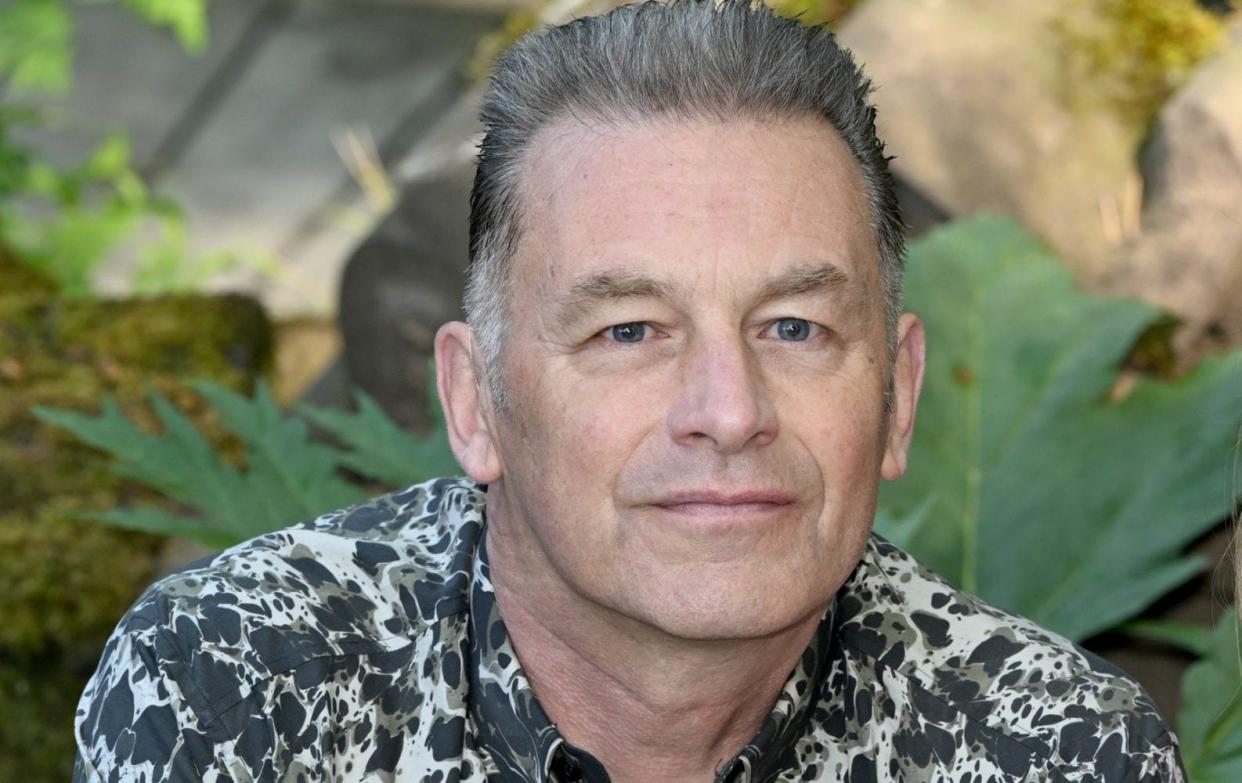
The tiny number of proprietors who are running vast environmentally damaging businesses may well be operating outside both codes of practice and the law, which would appear to be something that WildJustice might investigate.
The RSPCA’s accreditation arm, Freedom Food, is giving accreditation to the products coming from these farms. Over and above the disease, parasite, environmental and welfare issues, the accreditation documentation is clear that they are content for farmers to shoot harbour and grey seals to protect the welfare of the farmed fish.
The RSPCA/Freedom Food accreditation documentation states: “The shooting of seals is against the principles of the RSPCA Welfare Standards. However, at the present time, it is acknowledged that, as a last resort only, ie when all the non-lethal deterrents have been effectively deployed and the welfare of the fish is being compromised (ie they are being attacked), it may be necessary to use lethal measures to safeguard the welfare of the fish.”
As the high-profile president of the organisation, Mr Packham is perfectly placed to bring an end to the RSPCA’s apparent complicity in what is demonstrably one of the worst animal husbandry systems on the planet – a system that pollutes the oceans and produces food of a questionable quality.
Finally, the RSPB has for some reason avoided any contact with this appalling business. It was noted that when a clear opportunity to raise the issue presented itself in the production of Wild Isles, the television series co-produced by the RSPB, salmon farming was the elephant in the room. It would be of huge value if the RSPB made it clear that open net cage salmon farming is an ecological disaster.
Perhaps Mr Packham could use his position in Wild Justice, the RSPCA and RSPB to bring about some of the change that is desperately needed. I am not an expert in the details of every aspect of salmon farming, but I know enough to understand its consequences. It would be helpful if Mr Packham could publicly clarify his position.


